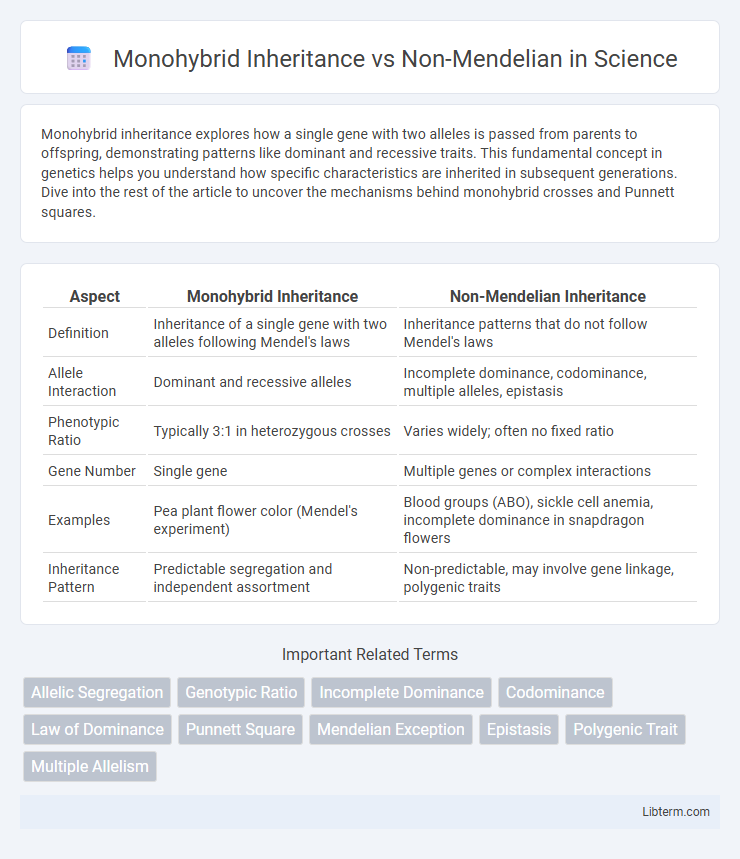Monohybrid inheritance explores how a single gene with two alleles is passed from parents to offspring, demonstrating patterns like dominant and recessive traits. This fundamental concept in genetics helps you understand how specific characteristics are inherited in subsequent generations. Dive into the rest of the article to uncover the mechanisms behind monohybrid crosses and Punnett squares.
Table of Comparison
| Aspect | Monohybrid Inheritance | Non-Mendelian Inheritance |
|---|---|---|
| Definition | Inheritance of a single gene with two alleles following Mendel's laws | Inheritance patterns that do not follow Mendel's laws |
| Allele Interaction | Dominant and recessive alleles | Incomplete dominance, codominance, multiple alleles, epistasis |
| Phenotypic Ratio | Typically 3:1 in heterozygous crosses | Varies widely; often no fixed ratio |
| Gene Number | Single gene | Multiple genes or complex interactions |
| Examples | Pea plant flower color (Mendel's experiment) | Blood groups (ABO), sickle cell anemia, incomplete dominance in snapdragon flowers |
| Inheritance Pattern | Predictable segregation and independent assortment | Non-predictable, may involve gene linkage, polygenic traits |
Introduction to Genetic Inheritance
Genetic inheritance encompasses patterns like monohybrid inheritance, where a single gene with two alleles follows Mendel's principles of dominance and segregation, producing predictable phenotypic ratios in offspring. Non-Mendelian inheritance deviates from these classical patterns, involving mechanisms such as incomplete dominance, codominance, multiple alleles, and polygenic traits that result in more complex inheritance patterns. Understanding these varieties is essential for comprehending the full spectrum of genetic variation and expression in organisms.
Defining Monohybrid Inheritance
Monohybrid inheritance involves the study of a single gene with two alleles, where one allele is typically dominant and the other recessive, as originally demonstrated by Gregor Mendel's pea plant experiments. This pattern follows predictable Mendelian ratios, such as the 3:1 phenotypic ratio in the F2 generation. Non-Mendelian inheritance, in contrast, includes patterns like incomplete dominance, codominance, and multiple alleles, where inheritance does not conform to these simple dominant-recessive rules.
Key Principles of Mendelian Genetics
Mendelian genetics centers on monohybrid inheritance, where a single gene with dominant and recessive alleles follows predictable segregation and independent assortment patterns. Key principles include the law of segregation, which states that allele pairs separate during gamete formation, and the law of independent assortment, where genes for different traits segregate independently. Non-Mendelian inheritance, by contrast, involves patterns like incomplete dominance, codominance, and mitochondrial inheritance that do not conform to these classic Mendelian ratios.
Overview of Non-Mendelian Inheritance
Non-Mendelian inheritance encompasses genetic patterns that deviate from classical Mendelian laws, including incomplete dominance, codominance, multiple alleles, and polygenic traits. These patterns reveal complex interactions between alleles where phenotypic outcomes cannot be predicted by simple dominant-recessive relationships, such as blood group inheritance or mitochondrial DNA transmission. Understanding non-Mendelian mechanisms enhances the study of genetic disorders and trait variability beyond monohybrid crosses.
Differences Between Monohybrid and Non-Mendelian Patterns
Monohybrid inheritance follows Mendel's laws, involving a single gene with two alleles exhibiting dominant and recessive traits, leading to predictable phenotypic ratios such as 3:1 in offspring. Non-Mendelian inheritance encompasses patterns like incomplete dominance, codominance, multiple alleles, polygenic traits, and mitochondrial inheritance, where traditional Mendelian ratios do not apply due to gene interactions or extranuclear DNA. Key differences include the number of genes involved, mode of allele interaction, and phenotypic outcomes that deviate from classic dominant-recessive relationships.
Examples of Monohybrid Inheritance in Organisms
Monohybrid inheritance involves the study of a single gene with two alleles, typically demonstrated by Gregor Mendel's classic experiments with pea plants exhibiting traits such as flower color and seed shape. Examples in organisms include Mendel's peas showing dominant round seeds versus recessive wrinkled seeds, fruit flies (Drosophila melanogaster) with eye color variations, and humans with traits like earlobe attachment. These examples contrast with Non-Mendelian inheritance, which includes incomplete dominance, codominance, and polygenic traits involving more complex gene interactions beyond simple monohybrid patterns.
Types of Non-Mendelian Inheritance Mechanisms
Non-Mendelian inheritance encompasses various patterns that deviate from classical Mendelian ratios, including incomplete dominance, codominance, multiple alleles, polygenic inheritance, and extranuclear inheritance. Incomplete dominance results in intermediate phenotypes, while codominance allows simultaneous expression of both alleles. Polygenic inheritance involves multiple genes contributing to a single trait, and extranuclear inheritance refers to gene transmission through organelles like mitochondria and chloroplasts, emphasizing the complexity beyond monohybrid inheritance.
Phenotypic Outcomes and Variability
Monohybrid inheritance follows Mendel's laws, where a single gene with two alleles produces predictable phenotypic ratios such as 3:1 in dominant-recessive interactions. Non-Mendelian inheritance includes phenomena like incomplete dominance, codominance, multiple alleles, and polygenic traits, resulting in greater phenotypic variability and unexpected segregation ratios. These complexities lead to phenotypic outcomes that deviate significantly from classic Mendelian predictions, highlighting the influence of gene interactions and environmental factors.
Implications for Genetic Counseling and Research
Monohybrid inheritance, characterized by single-gene traits following Mendelian ratios, provides a predictable framework crucial for genetic counseling in assessing risk for dominant or recessive disorders. Non-Mendelian inheritance, including incomplete dominance, codominance, and mitochondrial inheritance, introduces complexity in trait prediction, necessitating advanced genomic analysis and personalized consultation approaches. These distinctions impact research by guiding targeted gene studies and improving the development of diagnostic tools and therapeutic interventions tailored to diverse inheritance patterns.
Conclusion: Understanding Genetic Complexity
Monohybrid inheritance follows Mendelian principles with predictable dominant and recessive allele patterns, simplifying trait prediction across generations. Non-Mendelian inheritance reveals the genetic complexity through mechanisms like incomplete dominance, codominance, multiple alleles, and polygenic traits, where simple dominant-recessive relationships do not apply. Understanding these diverse genetic patterns is essential for grasping the full spectrum of heredity and the intricate nature of genotype-phenotype correlations.
Monohybrid Inheritance Infographic

 libterm.com
libterm.com